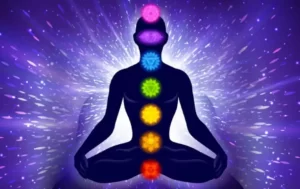What makes you, you? Is it your body, your thoughts, your emotions? According to Buddhism, the answer is none of the above. Instead, Buddhists believe in the concept of non-self, the idea that there is no permanent, unchanging self or soul that exists within us. At first, this idea may seem perplexing or even unsettling, but delving deeper into the concept of non-self can lead to a profound understanding of the nature of existence and the path to enlightenment.
“Buddhism teaches that everything is non-self. So who is the one affirming that everything is non-self?” Unknown.
– Anātman (Sanskrit) or anattā (Pali), represents one of the Three Marks of Existence (trilakṣaṇa) in Buddhism, illustrating the concept of non-self. This notion, unique to Buddhism, asserts that there is no ātman or attā (self), no enduring, unchanging essence within beings or phenomena. It implies that existence arises due to conditional co-production (dependent on circumstances) without any entity having control over its own creation or destruction. Therefore, in Buddhism, the self or “I” is considered non-existent, merely a collection of the five aggregates (pañcaskandha), which are in constant flux, arising and ceasing. (according to Wikipedia)
– Anattā, literally means “not-self,” has various interpretations. In Mahāyāna Buddhism, it refers to “non-self-existence”; in Theravāda Buddhism, it means “not mine, not myself.”
– Impermanence (anicca) pertains to observing reality in the temporal dimension, whereas non-self (anattā) pertains to the spatial dimension. These are two aspects of reality. Non-self is a manifestation of impermanence, just as impermanence is a manifestation of non-self. All phenomena lack an inherent self, thus they are impermanent. Impermanence signifies constant change, a universal truth. Since nothing is unchangeable, how can there be a distinct and enduring self? Discussing “self,” we refer to something that supposedly remains unchanged over time, but such an entity does not exist.
Thus, despite different expressions, the majority of contemporary Buddhist scholars agree that “anattā” implies the absence of a core, enduring essence within phenomena, hence, they are characterized by non-self or lack inherent nature.
What is Non-Self in Buddhism?

In Buddhist philosophy, the concept of Non-Self, also known as Anatta or Anātman in Sanskrit and Pali, fundamentally challenges the preconceived notion of a consistent, unchanging, and independent “self” or “soul” that resides within an individual.
In Buddhism, “Anatta” means that there is no inherent self existing within any object or phenomenon. Everything exists due to a convergence of conditions – there is no fixed, eternal essence.
All things lack an inherent self, hence they are impermanent. Impermanence means constant change, a fundamental truth. Without anything being unchangeable, how can there be a distinct, enduring self? When discussing “self,” we aim to refer to something that does not alter over time, yet nothing like that exists. Our bodies are impermanent, our emotions are impermanent, and our perceptions are likewise. Anger, sadness, love, hatred, and our mental states are all impermanent.
So, what permanent entity exists that we can identify as the Self? The sheet of paper on which these words are written has no separate self. It exists only due to the clouds, forests, sun, earth, and the labor and machinery used in paper production. Without these, the paper would not exist. When the paper is burned, where is its self?
Nothing can exist independently. Existence is dependent on many other elements. This is interdependence, the intricate relatedness of all things, always supporting each other. To exist means to inter-be. The paper inter-is (co-exists intricately related) with the sunlight and the forest. A flower cannot exist by itself; it inter-is with the soil, rain, weeds, and insects. There is no independent existence, only interdependence, the intricate relatedness among all things.
Looking deeply at a flower, we see it is made of non-flower elements. We can describe the flower as being made of everything else. There is nothing that does not exist in the flower. We see sunlight, rain, clouds, soil, and we also see time and space in the flower. Like everything else, a flower is entirely made of non-flower elements. The entire universe has come together to allow the flower to manifest. The flower contains everything except one thing: a separate self or independent nature.
A flower cannot be by itself. It must co-exist interdependently with the sun, clouds, and everything else in the universe. If we understand the meaning of existence as being present with other things, then we are closer to the truth. Interbeing or interdependence does not mean to exist or not exist but implies the absence of a separate nature, an independent self.
Instead, what we conventionally consider as “self” is an ever-changing aggregation of physical and mental phenomena, a construct of our perceptual apparatus, which Buddhism classifies into five aggregates: form, sensation, perception, mental formations and consciousness.
These aggregates are impermanent, always in flux, and inherently unsatisfactory. They interact and condition each other in complex ways, leading to the illusion of a cohesive, enduring self. This misapprehension results in clinging, desire, and ultimately, suffering, known as dukkha in Pali.
Scholars have noted that the doctrine of Non-Self does not demand the outright rejection of the conventional self. On the practical level, the Buddha acknowledged the utility of conventional language and concepts, including the notion of “person” or “individual.” Instead, the Non-Self teaching serves to deconstruct our ontological attachment to an inherent self, promoting the understanding of the ultimate reality that is free from our ordinary, dualistic conceptions.
Some Examples of Non-Self

The notion of Non-Self in Buddhism is complex and deeply interwoven with practical and philosophical facets of the tradition. For a comprehensive understanding of this concept, we can examine a few concrete examples that illuminate this notion in everyday life, introspective practice, and ethical behavior.
- The body: The body is considered non-self because it is constantly changing and aging. No cell in the body remains the same for long and the body is continuously renewing itself.
- Mental states: Mental states such as thoughts, emotions, and perceptions are also considered non-self because they arise and pass away in response to changing circumstances. They are not permanent and are constantly changing.
- Relationships: Relationships with others are also considered non-self because they are constantly changing and impermanent. People come and go in our lives, and our relationship with them changes over time.
- Material possessions: Material possessions are considered non-self because they are also subject to change and decay. They are not permanent and can be lost, stolen, or destroyed.
- Personal identity: Personal identity is considered non-self because it is constructed from constantly changing mental and physical components. Our thoughts, beliefs, and experiences are constantly changing, and therefore, our personal identity is also constantly changing.
1. Everyday life: Consider a personal attribute commonly associated with self-identity, such as your profession. You may think of yourself as a “teacher,” “engineer,” or “artist”. This label seems to provide a sense of continuity, stability, and uniqueness to your identity. However, in the light of Anatta, it is seen as a transient condition, subject to change, and dependent on numerous conditions—your education, opportunities, societal needs, personal interests, and health, among others. If any of these conditions change, your professional identity may also change. Thus, Anatta challenges us to perceive our identities not as fixed entities but as dynamically evolving phenomena, contingent upon a multitude of interdependent factors.
2. Introspective practice: Meditation serves as a potent tool for experientially realizing Anatta. During mindfulness or vipassana meditation, practitioners closely observe their thoughts, feelings, sensations, and perceptions. Rather than identifying with these experiences, they are taught to view them as transient, impersonal phenomena that arise and pass away. For instance, a sensation of pain is not “my pain” or “me,” but just a sensation that arises and ceases, dependent on various conditions. With sustained practice, this contemplative exercise can lead to a deep-seated realization of Non-Self.
3. Ethical behavior: Anatta also has profound ethical implications. Consider the act of generosity, known as dana in Buddhism. If one clings to a notion of self, the act of giving can be influenced by egoistic tendencies—”I am giving, this is my gift, they are the receiver.” But the understanding of Anatta transforms this act. The giver, the gift, and the recipient are seen as interdependent phenomena devoid of an inherent, separate self. Thus, the act of giving becomes a non-self act, free from self-referential attachments and expectations. This understanding can lead to selfless service, a key aspect of Buddhist ethics.
These examples illustrate the pervasive influence of the Non-Self concept in Buddhism. From mundane activities to introspective practices and ethical conduct, Anatta serves as a guiding principle that steers individuals towards liberation from clinging, suffering, and the cycle of birth and rebirth.
Why is Understanding Non-Self so Important?
The comprehension of the principle of Non-Self is integral to the Buddhist path because it directly pertains to the cessation of suffering, the primary concern of Buddhist teachings. Grasping this principle has profound implications for spiritual practice, ethical conduct, and the overall comprehension of Buddhist soteriology.
1. Liberation from suffering: A core tenet of Buddhism is that our suffering stems from ignorance (avidya), particularly about the nature of the self and the world. We typically perceive ourselves as unchanging, separate entities and cling to this notion of self, leading to craving, aversion, and suffering. Understanding Non-Self exposes this illusion and mitigates these afflictive tendencies. By observing the constant flux and interdependence of all phenomena, we gradually reduce our attachments, leading to a decrease in suffering and, ultimately, liberation.
2. Ethical conduct: An understanding of Non-Self shapes ethical behavior. When we perceive ourselves and others not as isolated entities, but as interconnected and interdependent, our attitudes and actions transform. Egoistic motivations give way to compassion, generosity, and other-oriented conduct, since harming others or the environment is seen as ultimately harming oneself. This perspective forms the basis of Buddhist ethics and the Bodhisattva ideal of working for the welfare of all beings.
3. Realization of emptiness: In Mahayana Buddhism, the understanding of Non-Self is closely related to the concept of śūnyatā, or Emptiness. This is not a nihilistic void, but the understanding that all phenomena lack inherent existence and are dependent on conditions. This realization of Emptiness and Non-Self is essential for the attainment of Nirvana, the cessation of suffering and the ultimate goal in Buddhism.
Understanding Non-Self offers a corrective lens to our habitual self-centered perceptions and attachments, guiding us towards a profound realization of reality that is conducive to the cessation of suffering, ethical living, and the attainment of Nirvana. This is why the Buddha placed such emphasis on the understanding of Non-Self in his teachings.
Theravada Buddhist View of Non-Self
In Theravada Buddhism, the concept of non-self (anatta in Pali) is considered one of the Three Universal Truths, along with suffering (dukkha) and impermanence (anicca). The teachings of non-self are central to Theravada Buddhism and are considered an essential aspect of the path to enlightenment.
The Theravada teachings on non-self emphasize the importance of seeing things as they truly are, free from illusions and delusions. By recognizing the impermanence of all things, including the self, one can let go of attachments and attain a state of peace and freedom.
Mahayana Buddhist View of Non-Self
The Mahayana Buddhist view of non-self is similar to the Theravada view in that it asserts that all things, including the self, are impermanent and lack a permanent essence. However, the Mahayana tradition places a greater emphasis on the idea of Emptiness (shunyata), which is the ultimate nature of all phenomena, including the self.
In the Mahayana tradition, the concept of non-self is closely tied to the teachings on emptiness. Emptiness refers to the idea that all things, including the self, lack inherent existence and are dependent on other factors for their existence.
Mahayana Buddhism teaches that our understanding of the self is distorted by our ignorance and delusions, and that our sense of self is just a mental construct. By realizing the emptiness of the self, one can overcome this ignorance and attain a state of wisdom and compassion.
The Mahayana view of non-self is also closely connected to the bodhisattva ideal, in which one strives to attain enlightenment not just for oneself, but for the benefit of all beings. This requires a deep understanding of the non-self nature of all things, including the self.
If Buddhism teaches the concept of non-self, then what is it that undergoes rebirth?

According to the doctrine of non-self, Buddhism is an atheistic religion that does not believe in a supreme being or an eternal soul. So, what is nirvana? Is Amitabha Buddha an eternal soul? Does the Western Pure Land exist? Without a self, what goes to rebirth?
If there is no permanent self, how can one determine the cause for a person’s rebirth into one of the six realms of samsara? Bodhisattvas return to the cycle of rebirth to help others, but without a “self” or an eternal soul, how do they know what to do? Without a self, who sees, hears, practices, creates karma, and receives the karmic consequences? Without a self, who understands the Dharma?
It’s hard to believe that the Buddha introduced the doctrine of non-self without understanding its significance in other religious traditions like Jainism and Brahmanism in India. Both traditions emphasize the existence of eternal, unchanging Hindu Selves in the modern world that cannot be destroyed.
The Buddha never provided any ancient evidence to support their existence, only stating that beings exist only as long as they are in the cycle of rebirth. When they attain Nirvana, they no longer exist as individuals.
The Buddha’s Nirvana is not to leave behind the world for eternity, but to escape the unreliable and unsatisfactory nature of impermanence and its changes.
Returning to the doctrine of Non-Self, Self is a hypothetical name used to describe a constantly changing set of mental factors (cetasika) that operate during a person’s life. Therefore, Self is empty and has no inherent essence to identify it.
Self of person A = Cetasika A1 + Cetasika A2 + Cetasika A3… Tomorrow, Self of person A becomes Self 2A = Cetasika A11 + Cetasika A21 + Cetasika A31… Rebirth of Self A = Rebirth of Cetasika A1 + Rebirth of Cetasika A2.
Each cetasika (mental factor) has a specific function, the feeling cetasika is responsible for experiencing happiness or suffering, the determining cetasika directs the mind, and enlightenment is achieved through the function of the wisdom cetasika. Thus, there is no self, but rather a continuous process of changing cetasikas.
However, there are differences between individuals. For example, the feeling cetasika of person A is different from that of person B, and cetasika A1 is different from cetasika B1. There is no fixed essence to identify the self, but there are differences.
These differences exist between this car and another car, between this phenomenon and another phenomenon. It is precisely these differences (between the components) that make us experience happiness and suffering. Therefore, practicing Anatta is a difficult method for ordinary practitioners like us.
By the way, are there differences between those who have attained enlightenment? Buddha did not teach his disciples with specific details, but kept everything open and undefined like existence, allowing them to discover the truth on their own. He wanted them to find the true nature of their own ultimate existence instead of explaining it to them.
Each of us knows the truth about ourselves by calming our surface personality to see if there is any fixed center deep within, or if everything is just an illusion.
The Buddhist Scriptures That Talk about Non-Self
The concept of non-self is a central teaching in Buddhism, and is discussed in several Buddhist scriptures. Some of the most notable scriptures that deal with non-self include:
- The Pali Canon – This is the collection of Buddhist scriptures in the Pali language, which is considered the oldest and most authoritative Buddhist scripture. The Pali Canon contains several discourses by the Buddha on the topic of non-self, including the famous Anatta-lakkhana Sutta (Discourse on the Characteristics of Non-Self).
- The Heart Sutra – This is a well-known Mahayana scripture that focuses on the concept of emptiness (shunyata) and its relationship to non-self. The Heart Sutra asserts that all things, including the self, are empty of inherent existence.
- The Diamond Sutra – Another important Mahayana scripture, the Diamond Sutra emphasizes the non-self nature of all things and the importance of realizing the impermanence of all phenomena, including the self.
- The Lankavatara Sutra – This is a Mahayana scripture that explores the concept of non-self in detail and its relationship to the path to enlightenment. The Lankavatara Sutra asserts that the understanding of non-self is essential for attaining liberation from suffering.
These scriptures emphasize the impermanence and lack of inherent existence of all things, including the self, and their significance in attaining liberation from suffering.





